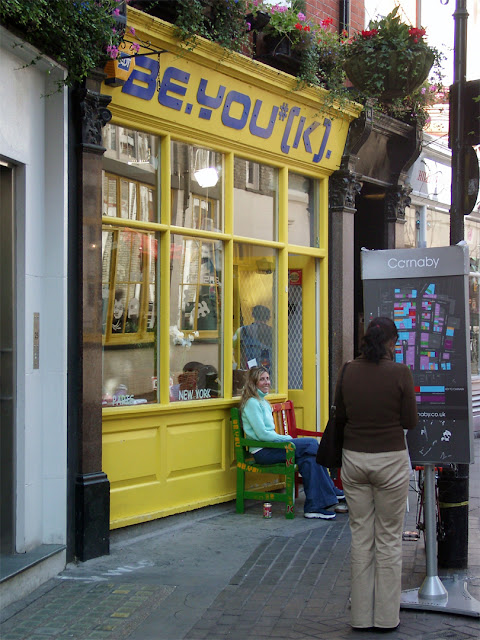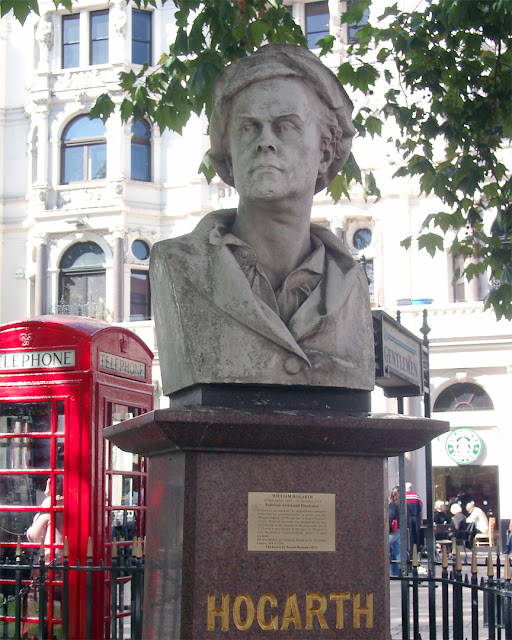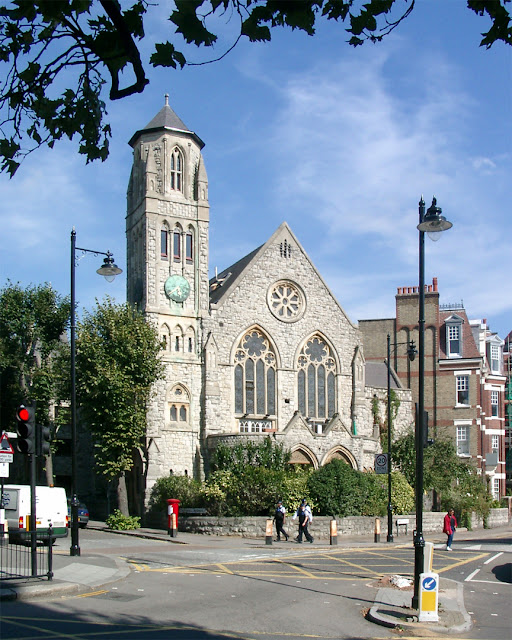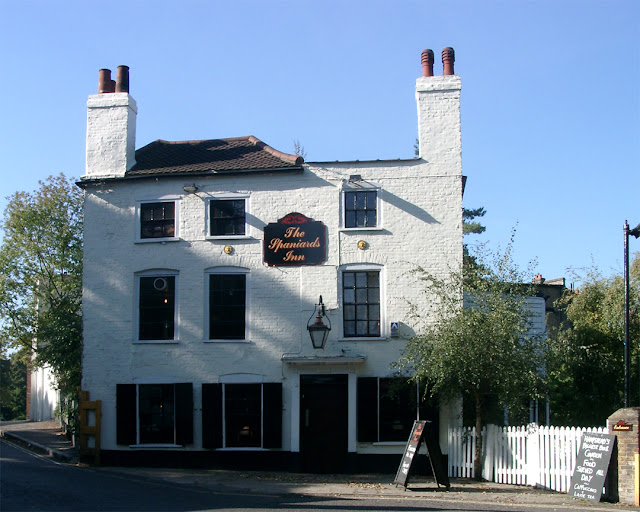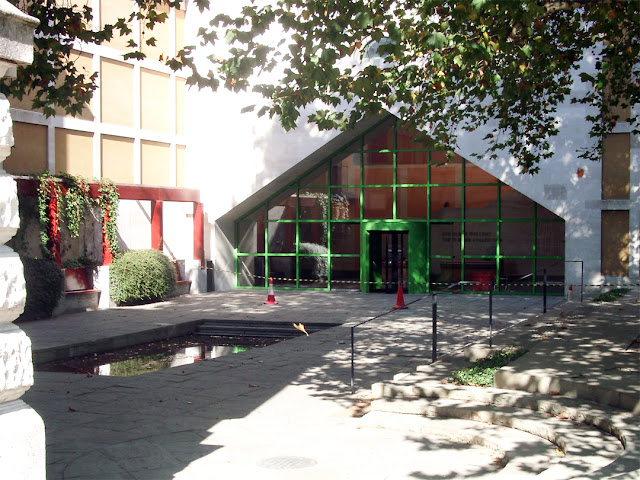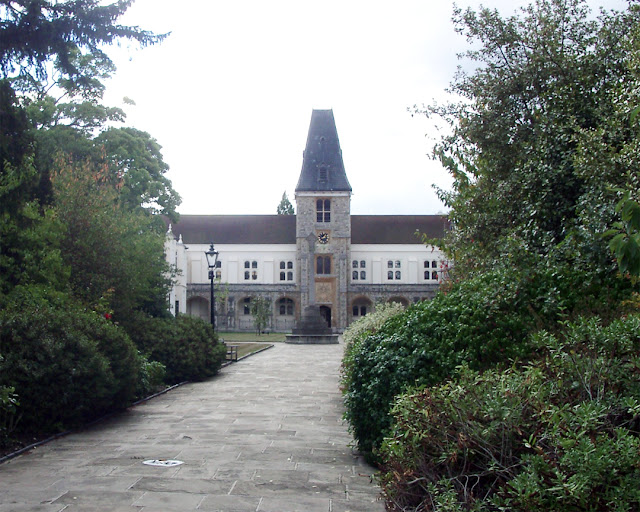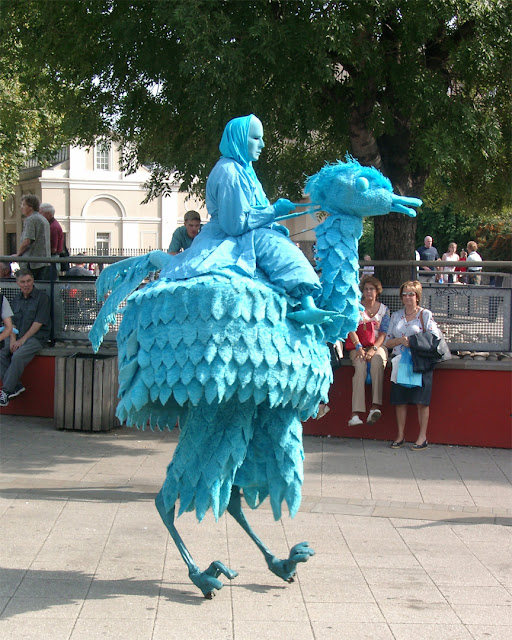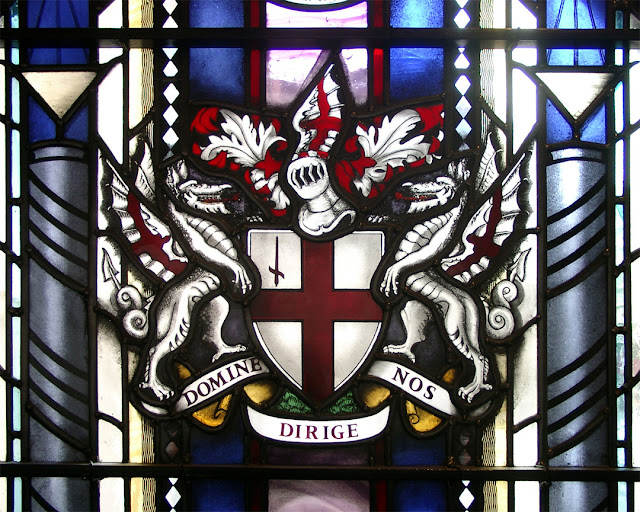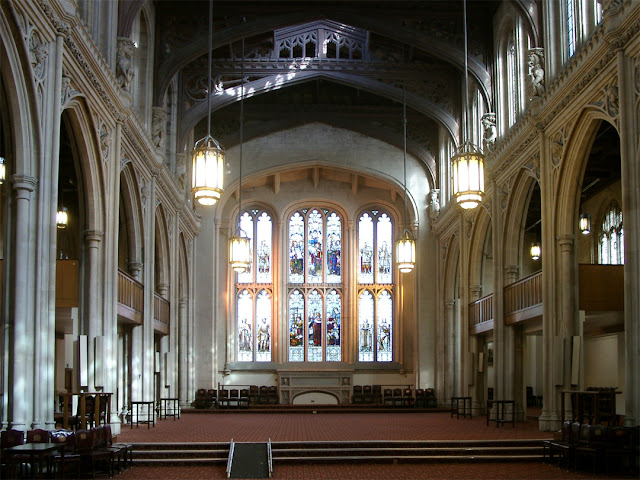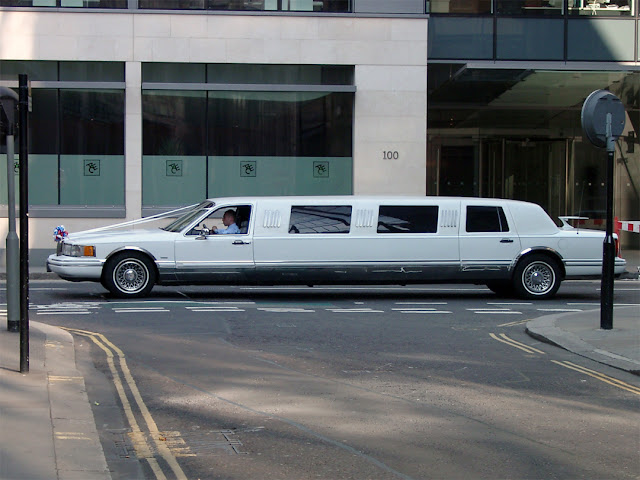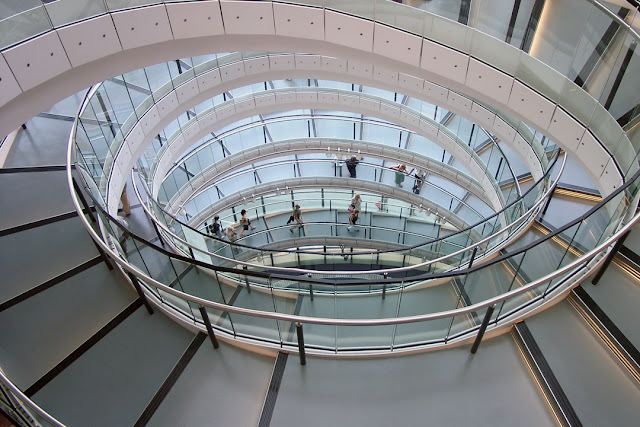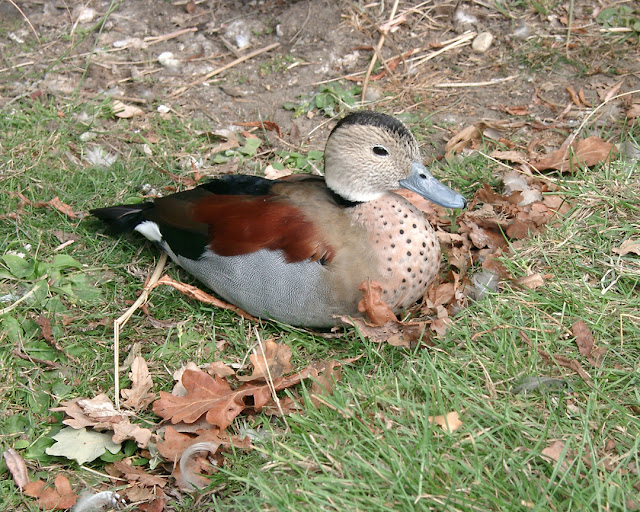Friday, December 31, 2004
Thursday, December 30, 2004
Great Court
Queen Elizabeth II Great Court
The British Museum
Great Russell Street, Bloomsbury
London, September 2003
“The Queen Elizabeth II Great Court, commonly referred to simply as the Great Court, is the covered central quadrangle of the British Museum in London. It was redeveloped during the late 1990s to a design by Foster and Partners, from a 1970s design by Colin St John Wilson. The court was opened by Queen Elizabeth II in 2000.” (Queen Elizabeth II Great Court, Wikipedia)
Wednesday, December 29, 2004
The Townley Discobolus
The Townley Discobolus
The British Museum
Great Russell Street, Bloomsbury
London, September 2003
“The Townley Discobolus, a Graeco-Roman copy of a fifth-century BC bronze statue, was excavated at Hadrian's Villa at Tivoli near Rome in 1791, and purchased by the dealer Thomas Jenkins the following year. After restoration by Carlo Albacini it was offered for sale in England and purchased by Charles Townley for the considerable sum of £400. Jenkins assured Townley that in form and quality the Discobolus was comparable to the famous version owned by the Massimo family, which had been discovered ten years before and which the antiquarian Carlo Fea had since identified as a copy of the famous statue by the Greek sculptor Myron. Although the head of Townley's statue had been broken off, Jenkins claimed that it had been discovered lying beside the torso on the site, writing to Townley on 27 September 1794: ‘The Head of Your Statue was not only found with it, but I believe You will See it is Precisely the Same Vein of Marble, that in Rome, there never was the slightest doubt of its authenticity’.” (The Townley Discobolus, The British Museum)
Tuesday, December 28, 2004
Tessellated roof
Queen Elizabeth II Great Court
The British Museum
Great Russell Street, Bloomsbury
London, September 2003
“The court has a tessellated glass roof, engineered by Buro Happold and built by Waagner-Biro, covering the entire court, and surrounds the original circular British Museum Reading Room in the centre, now a museum. It is the largest covered square in Europe. The glass and steel roof is made up of 4,878 unique steel members connected at 1,566 unique nodes and 1,656 pairs of glass windowpanes making up 6,100m2 of glazing; each of a unique shape because of the undulating nature of the roof.” (Queen Elizabeth II Great Court, Wikipedia)
Monday, December 27, 2004
Sunday, December 26, 2004
Saturday, December 25, 2004
Joshua Reynolds
Bust of Joshua Reynolds by Henry Weekes, 1874
Leicester Square
City of Westminster
London, September 2003
Friday, December 24, 2004
William Hogarth
Bust of William Hogarth by Joseph Durham, 1875
Leicester Square
City of Westminster
London, September 2003
Thursday, December 23, 2004
Dick Whittington’s Cat
Dick Whittington’s Cat by Jonathan Kenworthy, 1964
Highgate Hill
Archway, Islington
London, September 2003
“Dick Whittington and His Cat is the English folklore surrounding the real-life Richard Whittington (c. 1354–1423), wealthy merchant and later Lord Mayor of London. The legend describes his rise from poverty-stricken childhood with the fortune he made through the sale of his cat to a rat-infested country. However, the real Whittington did not come from a poor family of common stock, and there is no compelling evidence supporting the stories about the cat, or even whether he owned one. Another element in the legend is that Dick attempted to flee his service as a scullion one night, heading towards home (or reached Highgate Hill in later tradition), but was dissuaded by the sound of Bow bells, which promised he would be mayor of London one day. Since the pre-Victorian era, the story has been a favourite subject of British pantomime, especially during Christmas season.” (Dick Whittington and His Cat, Wikipedia)
Wednesday, December 22, 2004
Highgate United Reformed Church
Former Highgate Presbyterian Church
(later known as Highgate United Reformed Church)
Hornsey Lane / Cromwell Avenue
London, September 2003
Tuesday, December 21, 2004
Kenwood House
Kenwood House
Hampstead Heath, Camden
London, September 2003
“Kenwood House (also known as the Iveagh Bequest) is a former stately home in Hampstead, London, on the northern boundary of Hampstead Heath. The house was originally constructed in the 17th century and served as a residence for the Earls of Mansfield during the 18th and 19th centuries. The house and part of the grounds were bought from the 6th Earl of Mansfield in 1925 by Edward Guinness, 1st Earl of Iveagh, and donated to the nation in 1927. The entire estate came under ownership of the London County Council and was open to the public by the end of the 1920s. It remains a popular local tourist attraction.” (Kenwood House, Wikipedia)
Monday, December 20, 2004
The Spaniards Inn
The Spaniards Inn
Spaniards Road
Hampstead, Barnet
London, September 2003
“The Spaniards Inn is a historic pub on Spaniards Road between Hampstead and Highgate in London, England. It lies on the edge of Hampstead Heath near Kenwood House. It is a Grade II listed building, dating back to the 16th century. The pub is believed to have been built in 1585 on the Finchley boundary, with the tavern forming the entrance to the Bishop of London's estate—an original boundary stone from 1755 can still be seen in the front garden. Opposite it there is a toll house built in around 1710. Today, the pub is in Barnet and the tollhouse is in Camden, both are now listed buildings and traffic is reduced to one lane between the two. A suggestion in 1966 to demolish the tollhouse was successfully resisted, partly on the grounds that it would lead to more and faster traffic.” (Spaniards Inn, Wikipedia)
Sunday, December 19, 2004
Saturday, December 18, 2004
Clore Gallery
Clore Gallery by James Stirling, 1987
Tate Britain
Millbank, City of Westminster
London, September 2003
“Tate Britain includes the Clore Gallery of 1987, designed by James Stirling, which houses work by J. M. W. Turner. The Clore Gallery has been regarded as an important example of Postmodern architecture, especially in the use of contextual irony: each section of the external facade quotes liberally from the building next to it in regard to materials and detailing.” (Tate Britain, Wikipedia)
Friday, December 17, 2004
The Death of Dirce
“The Death of Dirce” by Charles Lawes-Wittewronge, 1906
Tate Britain
Millbank, City of Westminster
London, September 2003
Thursday, December 16, 2004
Wednesday, December 15, 2004
September 11 Memorial Garden
September 11 Memorial Garden
Grosvenor Square, Mayfair
London, September 2003
“Time is too slow for those who wait, too swift for those who fear, too long for those who grieve, too short for those who rejoice, but for those who love, time is not”
“This garden was created in memory of all those who lost their lives in the 11th September 2001 terrorist attacks on the United States of America”
Tuesday, December 14, 2004
College of God's Gift
The Old College complex, including Christ's Chapel of God's Gift
College of God's Gift (Old Dulwich College)
Dulwich, Southwark
London, September 2003
Monday, December 13, 2004
Dulwich Picture Gallery
Dulwich Picture Gallery
Gallery Road
Dulwich, Southwark
London, September 2003
“Dulwich Picture Gallery is an art gallery in Dulwich, South London, which opened to the public in 1817. It was designed by Regency architect Sir John Soane using an innovative and influential method of illumination. Dulwich is the oldest public art gallery in England and was made an independent charitable trust in 1994. Until this time the gallery was part of Edward Alleyn's College of God's Gift, a charitable foundation established by the actor, entrepreneur, and philanthropist Edward Alleyn in the early-17th century. The acquisition of artworks by its founders and bequests from its many patrons resulted in Dulwich Picture Gallery housing one of the country's finest collections of Old Masters, especially rich in French, Italian, and Spanish Baroque paintings, and in British portraits from Tudor times to the 19th century.” (Dulwich Picture Gallery, Wikipedia)
Sunday, December 12, 2004
Saturday, December 11, 2004
Friday, December 10, 2004
Thursday, December 9, 2004
Wednesday, December 8, 2004
Tuesday, December 7, 2004
Cutty Sark bell
The bell of the “Cutty Sark”
King William Walk, Greenwich Peninsula
London, September 2003
“In 1953 Cutty Sark was given to the Cutty Sark Preservation Society and in 1954 she was moved to a custom-built dry dock at Greenwich. She was stripped of upper masts, yards, deck-houses and ballast to lighten her before being towed from the East India Import Dock to the special dry dock at Greenwich. The skipper on this occasion was 83-year-old Captain C.E. Irving, who had sailed the world three times in her before he was 17. The river pilot was Ernest Coe. Thereafter the entrance tunnel to the dry dock was filled in, the river wall rebuilt and the work of re-rigging began. The foundation stone of the dry dock was laid by The Duke of Edinburgh, patron of the Cutty Sark Preservation Society, in June 1953. The restoration, re-rigging and preparation for public exhibition was estimated to cost £250,000.” (Cutty Sark, Wikipedia)
Monday, December 6, 2004
125 London Wall
Alban Gate by Terry Farrell, 1992
London Wall, City of London
London, September 2003
“125 London Wall, also known as Alban Gate, is a postmodernist building on London Wall in the City of London. Along with Embankment Place and Vauxhall Cross, it has been described as one of the three projects that established designer Sir Terry Farrell's reputation in the late 1980s-to-early 1990s period. In 2004, writer Deyan Sudjic described it as ‘postmodernism at its most exuberant’, placing it at number 5 in a list of Ten Triumphs of recent UK architecture.” (125 London Wall, Wikipedia)
Sunday, December 5, 2004
Domine dirige nos
“Domine dirige nos” (Lord, direct us)
Coat of arms of the City of London
Guildhall
Basinghall Street, City of London
London, September 2003
Saturday, December 4, 2004
Old Library and Print Room
Old Library and Print Room
Great Hall, Guildhall
Basinghall Street, City of London
London, September 2003
Friday, December 3, 2004
Winston Churchill
Winston Churchill by Oscar Nemon, 1955
Great Hall, Guildhall
Basinghall Street, City of London
London, September 2003
Thursday, December 2, 2004
Wednesday, December 1, 2004
Tuesday, November 30, 2004
The World Has Been Empty
“The World Has Been Empty Since the Romans” by Ian Hamilton Finlay, 1985
Tate Modern
Bankside, Southwark
London, September 2003
“The World Has Been Empty Since the Romans 1985 is a long and extremely heavy stone sculpture that resembles the ruin of a classical frieze and hangs from a series of steel chains. The text of its title – ‘THE WORLD HAS BEEN EMPTY SINCE THE ROMANS’ – is inscribed across its front in a traditional-looking serif typeface. The sculpture is made from six pieces of Bath stone, which is a form of limestone, and the faces of the stones are quite smooth, but are marked by what look like signs of weathering. They have jagged tops, bottoms and sides and the inscribed text is often broken up by joins between the different slabs, as well as what look like missing sections of stone. There is no fixed height from which the work must be hung, so that in some exhibitions it has been presented well above head height and in others it has been suspended only a short distance from the ground. However, all of the stones are hung at the same level as each other every time it is installed.” (The World Has Been Empty Since the Romans, Tate)
Monday, November 29, 2004
LSE Library ramp
Spiral stepped ramp
British Library of Political and Economic Science
Portugal Street, Holborn
London, September 2003
“The library underwent a £35 million building redevelopment in 2000, overseen by Foster and Partners. The building was officially reopened on 27 November 2001 by The Princess Royal and was commended in the 2002 Civic Trust Awards - given to outstanding examples of architecture and environmental design in major city areas of the UK, taking into account the benefit each project brings to its local area as well as the quality of its design. A further redevelopment in summer 2007, saw the expansion of the Course Collection by 60%, a new help desk, more study spaces and an increase in self-service facilities. The Lionel Robbins Building covers 20,000 square metres, and offers 1,700 study places, including 450 networked PCs and 226 laptop drop-in points. A light-filled atrium, named after Michael Peacock and spiral stepped ramp culminate at the top in a partially glazed dome which has been precisely angled to maximise daylight with minimal solar glare. A reflecting panel on the roof also helps to direct sunlight to the floors below. The dome and other windows respond automatically according to the temperature in the building; ventilating it naturally.” (British Library of Political and Economic Science, Wikipedia)
Sunday, November 28, 2004
LSE Library Atrium
Atrium
British Library of Political and Economic Science
Portugal Street, Holborn
London, September 2003
“The library underwent a £35 million building redevelopment in 2000, overseen by Foster and Partners. The building was officially reopened on 27 November 2001 by The Princess Royal and was commended in the 2002 Civic Trust Awards - given to outstanding examples of architecture and environmental design in major city areas of the UK, taking into account the benefit each project brings to its local area as well as the quality of its design. A further redevelopment in summer 2007, saw the expansion of the Course Collection by 60%, a new help desk, more study spaces and an increase in self-service facilities. The Lionel Robbins Building covers 20,000 square metres, and offers 1,700 study places, including 450 networked PCs and 226 laptop drop-in points. A light-filled atrium, named after Michael Peacock and spiral stepped ramp culminate at the top in a partially glazed dome which has been precisely angled to maximise daylight with minimal solar glare. A reflecting panel on the roof also helps to direct sunlight to the floors below. The dome and other windows respond automatically according to the temperature in the building; ventilating it naturally.” (British Library of Political and Economic Science, Wikipedia)
Saturday, November 27, 2004
Friday, November 26, 2004
Helical walkway
Helical walkway
City Hall by Foster and Partners, 2002
The Queen's Walk, Southwark
London, September 2003
Thursday, November 25, 2004
Wednesday, November 24, 2004
Blaine's crane
David Blaine's “Above the Below”
Potters Fields Park
Southwark
London, September 2003
“On September 5, 2003, Blaine began an endurance stunt in which he was sealed inside a transparent Plexiglas case. The case was suspended 30 feet (9.1 metres) in the air next to Potters Fields Park on the south bank of the River Thames in London, and measured 3 feet (0.9 metres) by 7 feet (2.1 metres) by 7 feet (2.1 metres). A webcam was installed inside the case so that viewers could observe his progress. The stunt lasted 44 days, during which Blaine drank 1.2 US gallons (4.5 litres) of water per day and did not eat. The stunt was the subject of public interest and media attention, The Times reported that ‘1,614 articles in the British press have made reference to the exploit.’” (David Blaine, Wikipedia)
Tuesday, November 23, 2004
Chelsea Bridge
Chelsea Bridge
Chelsea / Battersea
London, September 2003
“Chelsea Bridge is a bridge over the River Thames in west London, connecting Chelsea on the north bank to Battersea on the south bank, and split between the City of Westminster, the London Borough of Wandsworth and the Royal Borough of Kensington and Chelsea. There have been two Chelsea Bridges, on the site of what was an ancient ford.” (Chelsea Bridge, Wikipedia)
Monday, November 22, 2004
The Japanese Eagle
The Japanese Eagle
Queen Mary’s Gardens
Regent's Park
London, September 2003
“This statue, in the middle of the lake in Queen Mary’s Gardens, was given to the Park in 1974 by Felix Greene in memory of his father, Edward Greene, who had been a very successful coffee merchant, spending 20 years in Brazil before returning to London 1910, and later becoming chairman of the Brazilian Warrant Company. The eagle had been in the garden of Edward Greene’s lovely farmhouse at Little Wittenham, near Oxford, during the 1930s. It was recently restored to its former glory.” (The Japanese Eagle, The Royal Parks)
Sunday, November 21, 2004
Saturday, November 20, 2004
Friday, November 19, 2004
Ready Money Drinking Fountain
Ready Money Drinking Fountain
Broad Walk
Regent's Park
London, September 2003
“The Ready Money Drinking Fountain is a four-sided granite and marble gothic drinking fountain that gets its unusual name from Sir Cowasjee Jehangir, whose nickname was Ready Money. It is located in the centre of the Broad Walk. Ready Money was a wealthy Parsee industrialist from Bombay who donated it to The Regent's Park in 1869 as a thank-you for the protection that he and fellow Parsees received from British rule in India. The sculpture contains 10 tonnes of Sicilian marble and four tonnes of red Aberdeen granite. It was unveiled by Princess Mary of Teck, later Queen Mary after whom Queen Mary's Gardens are named.” (Ready Money Drinking Fountain, The Royal Parks)
Thursday, November 18, 2004
Wednesday, November 17, 2004
Tuesday, November 16, 2004
Monday, November 15, 2004
Doric Villa
Doric Villa by Quinlan Terry
Seen from the Regent's Canal
Outer Circle, Regent's Park
London, September 2003
Sunday, November 14, 2004
Ionic Villa
Ionic Villa by Quinlan Terry
Seen from the Regent's Canal
Outer Circle, Regent's Park
London, September 2003
Saturday, November 13, 2004
Veneto Villa
Veneto Villa by Quinlan Terry
Seen from the Regent's Canal
Outer Circle, Regent's Park
London, September 2003
Friday, November 12, 2004
Subscribe to:
Comments (Atom)






